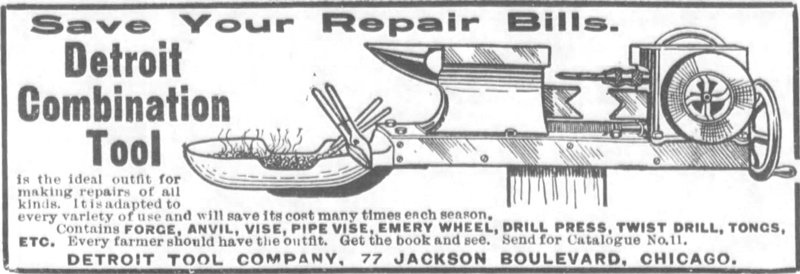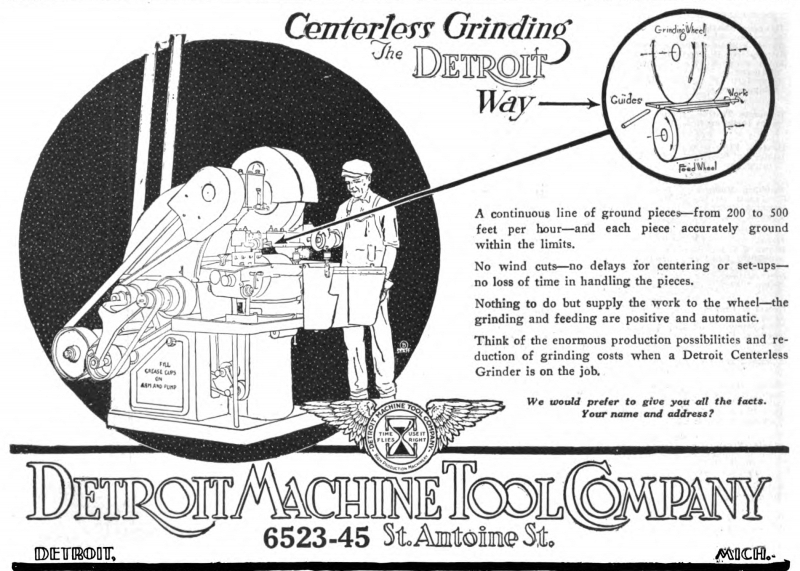
1906
Beginning in late 1905 through at least 1911, Detroit Tool Co. manufactured the Detroit Combination Tool in two sizes, possibly the most elaborate vise-anvil-drills made. "Both size tools contain a forge, anvil, vise, pipe vise, emery wheel, drill press, vise clamps, anvil hardy, crucible holder, twist drill and blacksmith tongs. All gears are covered and have clutch arrangement by which they can be thrown in or out of gear as desired." The business was one of many enterprises of William L. Holmes (1859-1915). He was president of the Detroit Telephone Co., Puritan Brick Co., and two cement companies, and he had a thriving real estate development business. The machine was developed by his son, Harold W. Holmes, from the ideas of J. W. Morrison, Detroit physician. The company's incorporation was announced Oct. 27, 1905. The machine was sold by a national network of drummers, solicited with an aggressive nationwide advertising campaign that applied lessons Holmes learned from his real estate business. The company was barely a month old when a Des Moines "Agents Wanted" ad cited income of $5 to $20 per day and, "Live, reliable agents wanted everywhere." A Phoenix ad a week later claimed, "The Detroit Combination Tool is the greatest invention of the age. Needed by every household, ranch and mine in Arizona." The nationwide ads continued into 1911, but it's unknown how long production continued.
While the record is unclear, it appears that in the early teens the company took on contract manufacturing of small machined automobile parts. They began developing specialized machine tools for this purpose, and then began selling the machines. By 1914 the product line had shifted to semi-automatic drilling machines and a box-column sensitive drill press of unusually heavy construction.
William L. Holmes died Oct. 30, 1915, and Harold W. Holmes took over Detroit Tool Co., becoming president and general manager. Holmes was also involved in several of his father's other businesses, but he had a degree in mechanical engineering from Michigan, and it appears that machine tool design was his primary interest. Holmes was a pioneer in the development of centerless grinding, a process important to Detroit's automotive industry. The firm discontinued making parts in 1918 to concentrate on machine tools. The company's name changed about 1920 to Detroit Machine Tool Co. to reflect their technologically sophisticated product line. They moved into a new, larger plant in early 1921, enabling parts manufacturing to resume. In Aug. 1924 Detroit Machine Tool Co. consolidated with Norton Co. Norton was attracted to the centerless grinders that the Detroit firm had developed. Holmes remained as president and general manager.
The company had several plant addresses, including 39-45 W. Congress St. through 1916, 1489 St. Antoine St. in 1917-1920, and 6523-45 St. Antoine St. in 1921-1924.

1922
Information Sources
- Detroit Free Press, Oct. 27, 1905, Pg. 8.
- Detroit Free Press, Nov. 3, 1905, Pg. 5.
- Arizona Republic (Phoenix, AZ), Dec. 9, 1905, Pg. 7.
- Cycle and Automobile Trade Journal, Vol. X, No. 9, Mar. 1, 1906, Pg. 284
- Detroit Free Press, Nov. 1, 1915, Pg. 9.
- Find-A-Grave memorial William Lane Holmes Holmes' grave has an obelisk that reflects his accomplishments, which were considerable.
- Detroit Free Press, Aug. 31, 1924, Pg. 21.
- Historic Michigan : Land of the Great Lakes, Ed. George N. Fuller, National Historical Association, Inc., 1924, Pg. 548-549.